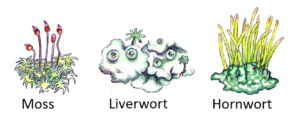What is the difference between liverworts and mosses?
How can you distinguish a moss from a liverwort tend to give a lot of learners a hard time especially when they are revising for their biology practical exam? These two terms happen to be examples of Bryophyta phylum.
The lesson provides detailed insights into the difference between liverworts and mosses with a comparison table. Besides that, you will be able to learn more about the similarities between liverworts and mosses.

What Are Liverworts?
Liverworts are non-vascular plants with leaf-like lobes or stems. These plants belong to the division of Marchantiophyta which is under the phylum bryophyte. The prominent generation of liverworts is gametophyte.
These plants grow by sprawling across the soil, rocks, and other plants. The rhizoids of the plants are responsible for the attachment on the substrate and absorbing water. The less prominent generation of liverworts is sporophyte which developed from fertilization of gametes and it results in the sporangium production at the apex.
Examples of liverworts are Riccia, Marchantia, and Perella.
What Are Mosses?
Mosses are non-vascular plants consisting of leafy stems. The leaves and stems of mosses are not true. These plants belong to the phylum bryophyte and termed as the largest in the phylum. The sporophyte of the plant is attached to the female gametophyte which comprises of capsule and seta.
The capsule of the plant is normally covered with operculum which falls off after ripening of the capsule. The seta holds the sporangium to the wind. Examples of mosses are Funaria, Polytrichum, and Sphagnum.
Comparison Chart: Liverworts Vs Mosses
| Basic Terms | Liverworts | Mosses |
| Meaning | Non-vascular plants consisting of leaf-like lobes or stems | Non-vascular plants consisting of leafy stems |
| Division | Marchantiophyta | Bryophyta |
| Morphology of the Gametophyte | Thallose | Foliose |
| Symmetry | Dorsiventral or radial | Radial |
| Rhizoids | Unicellular | Multicellular |
| Protonemata | Are reduced | Are prominent |
| Leaf Arrangement | Are arranged in two or three rows in a flattened pattern | Are arranged in a spiral or whorl pattern |
| Branching | Generally dichotomous | lateral and extra-axillary |
| Amphigastria | Present | Absent |
| Examples | Riccia, Marchantia, and Porella | Funaria, Polytrichum, and Sphagnum |
Core Differences between Liverworts and Mosses
- The rhizoids of liverworts are unicellular while that of mosses are multicellular
- The leaf arrangement of liverworts are in two or three rows in a flattened pattern while those of mosses have a spiral arrangement
- The branching of liverworts is dichotomous while that of mosses is lateral and extra-axillary
- The protonemata in liverworts are reduced while in mosses are prominent
- The symmetry of liverworts are dorsiventral while that of mosses are radial
- The morphology of gametophyte of liverworts are thallose while that of mosses are foliose
- The division of liverworts is Marchantiophyta while that of mosses is Bryophyta.
- Examples of liverworts are Riccia, Marchantia, and Porella while those of mosses are Funaria, Polytrichum, and Sphagnum
- Liverworts are non-vascular plants consisting of leaf-like lobes or stems while mosses are non-vascular plants consisting of leafy stems
- The columella is absent in liverworts while present in mosses
- Peristome teeth are absent in liverworts while present in mosses
- The capsule often possesses elater in liverworts while Elaters are absent in mosses
- Amphigastria are present in liverworts while absent in mosses
Core Similarities between Liverworts and Mosses
- Both are terrestrial plants
- Both are small plants with different sporophytes and gametophytes.
- The gametophyte is dominant over sporophyte in both plants
- Both consists of chloroplast
- Both are non-vascular plants
- Both are non-flowering plants
- Both lack true stems, roots, and leaves
- Both have rhizoids
- Stomata and cuticle lack in both plants
- Fertilization of both plants depend on water
- Sporogonium is separated into the capsule, foot, and seta
- Both belong to the phylum bryophyte
- Both have stem-like structures and leaf-like structures
Comparison Video
Summary
The core difference between liverworts and mosses is that liverworts gametophyte is thallose while that of mosses is foliose. The core similarity between liverworts and mosses is that both are terrestrial and wet environment plants.